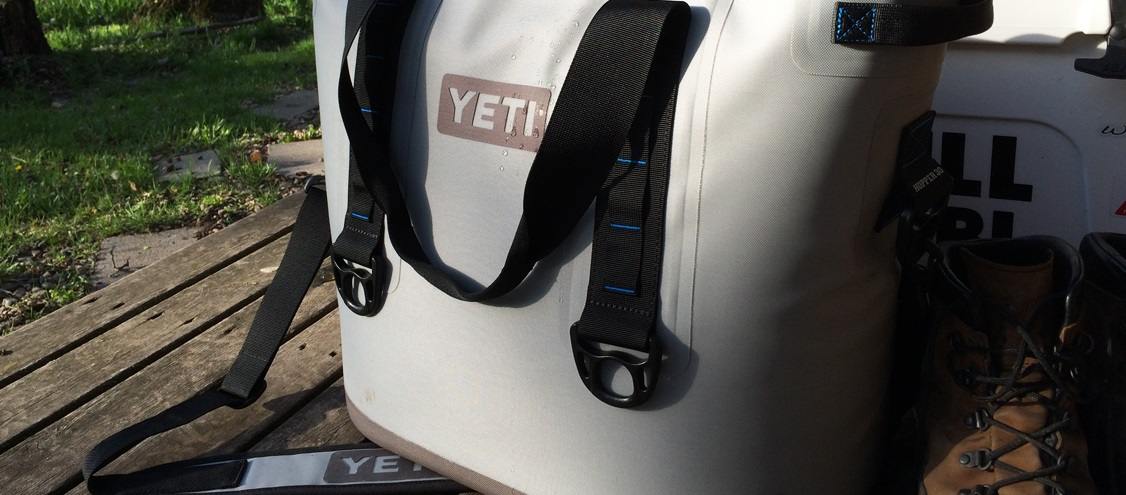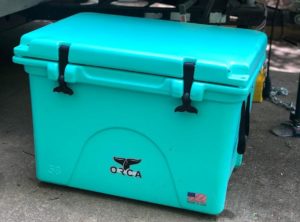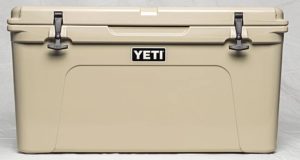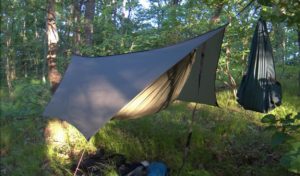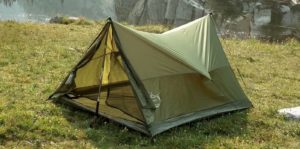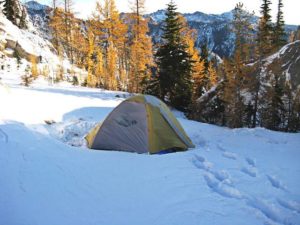Want to bring some frosty beverages to the beach? We reviewed over two dozen soft coolers, then tested the best eight. Soft coolers can offer a perfect blend of portability and performance for picnics, for use as an everyday lunchbox, or for trekking some frosty beverages up to a scenic overlook. However, finding the best model for each of these uses can be a bit tricky. In our review, we meticulously evaluated insulation value, durability, and portability, so that you can find the exact cooler that will best fit your specific needs. If you’re looking for something a bit larger and sturdier check out our hard cooler review.
Best Soft Cooler – Quick Answer
-
Best Overall: YETI Hopper Two
-
Best Budget Cooler: Polar Bear Coolers
-
Best Long Distance: Ice Mule Pro
-
Best Small Cooler: Yeti Hopper 12 Flip
-
Best LunchBox: eBags Crew Cooler II
Best Overall Soft Cooler: YETI Hopper Two 30
- Extremely durable
- Easy to use
- Great insulation
- Very Expensive
- Awkward to carry when full for long distances
With impressive insulation performance, a nearly indestructible construction, and comfortable shoulder strap, the Yeti Hopper Two 30 was far and away our favorite soft cooler. In our review, it kept drinks cold for a full three days, and was comfortable enough to carry that we didn’t mind trekking it along the beach or even for short hikes, even when it was totally loaded with cans and ice. This new version also features a redesigned zipper that makes loading and unloading much easier. Seeing as this was our only gripe with the old version of the Hopper, this new version feels near perfect.
Best Budget Pick: Polar Bear Coolers 24 Pack
- Amazing insulating power for the price
- Relatively inexpensive
- Not very durable
The Polar Bear Coolers 24 Pack was the underdog of our review. It is moderately priced and simple in build and appearance. The old adage “don’t judge a book by its cover’ certainly applies here. When tested head-to-head against the almost 4.5 times more expensive Yeti Hopper Two 30, the Polar Bear was able to hold its own better than any other model reviewed. It held only five fewer ounces of ice over a 72-hour period than the Yeti. The other coolers that we compared in this category held onto no ice after the same 72-hour period. This is one solid cooler and the other features of the Polar Bear weren’t lacking, either. Easy to use and relatively comfortable shoulder strap and carrying handles plus a quality zipper added to the positive attributes, and the included bottle opener sealed the deal.
Best for Long Distance Carrying: Ice Mule Pro
- Relatively inexpensive for the whole package
- Extremely easy to carry when full
- Awkward if not fully packed
- Not as insulative as other coolers.
The Ice Mule Pro was one of our personal favorite soft coolers. What it didn’t have in insulation power it made up for with highly useful portability and long haul design. The Ice Mule is made for multi-mile hikes, and easy comfort while doing it. Equipped with padded backpack straps and a padded and ventilated back panel, it has more of a backpack feel than that of a cooler. The Ice Mule surprised and surpassed our expectations and out-performed others for ease of use and portability at every turn. The roll top is quick and easy, and when closed properly is leak free. The air release valve helps keep loads secure and tight, and the durability is top notch. If you are looking for something to take out to more remote country or even something that is just easy to carry, the Ice Mule is for you.
Great Insulation in a Small Package: YETI Hopper Flip 12
Due to inch thick insulation, a cubic shape, and relatively small size, the Yeti Hopper 12 Flip was the top performer in our insulation test. It’s a bit small for picnics or carrying drinks for a group of people, but can keep a 12-pack ice cold for days. It’s perfect for those sweltering summer days where having a few chilled drinks can mean the difference between a nice day out and googling ‘heat stroke symptoms’ on your phone.
Great Lunchbox: eBags Crew Cooler II
- Multiple pockets
- Removable/replaceable liner
- Not as insulative as other models
- Not as durable as other models
If you’re looking for something that can ferry your lunch to work, the eBags Crew Cooler II strikes a near-perfect balance of performance, portability, and features. It wasn’t a standout in our insulation testing but still has enough power to keep your cold cuts cold until your lunch break. It also has separate compartments for utensils and water bottles, and has a liner that can be removed for cleaning when the mustard leaks out of your sandwich.
Like everything, there are different uses for different products, even within a category such as soft coolers. While any of them will get your brews to the game, some are better suited than others for a day out in rugged terrain, and some are better made for a day in the park. We decided to take a look at the whole range to see what we could find out.
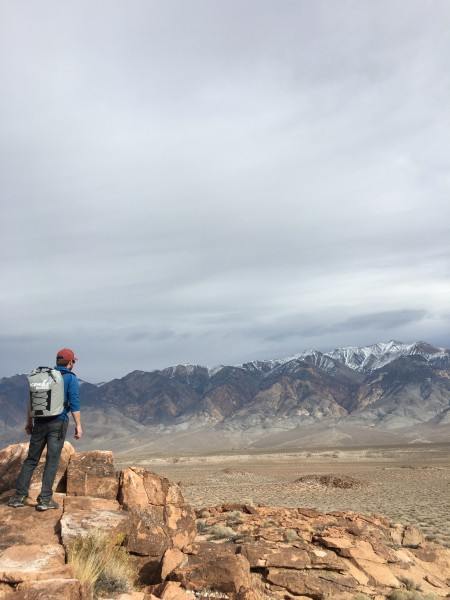
For more of our camping gear recommendations, check these guides:
How We Chose the Best Coolers
In order to get the best picture of what could and could not, be done with the various products selected for review, we used a series of evaluation metrics in order to rate each model next to each other. Each metric, and testing measures to quantify them, were designed and performed with overall performance in mind. In total, we looked at five different criteria.
Insulation Value
Keeping things cold is priority one for all coolers, so our insulation value metric was the most heavily weighted and most stringently tested. While it is true that size does affect overall insulation value, thermodynamics dictate that heat will dissipate more slowly from a larger volume and conversely a larger volume of cold material will absorb heat slower, thus warm more slowly; i.e. the pile of snow left by the plow after winter, the larger it is the longer it lasts. However the size of your ice chest should be chosen based on your intended application, and with the exception of the lunchbox-sized Coleman 16-Can, all our test models were of roughly similar size.
We wanted to look at just how well our selection of products performed at the task for which they were created. Insulation value is the result of a number of different factors. In coolers, it boils down to the type of insulation and the amount/thickness of that insulation. As a general rule, the more insulation the more keep cold power your icebox will have. The quality of modern insulation varies slightly by type, but for the most part, they are all pretty on par with each other.
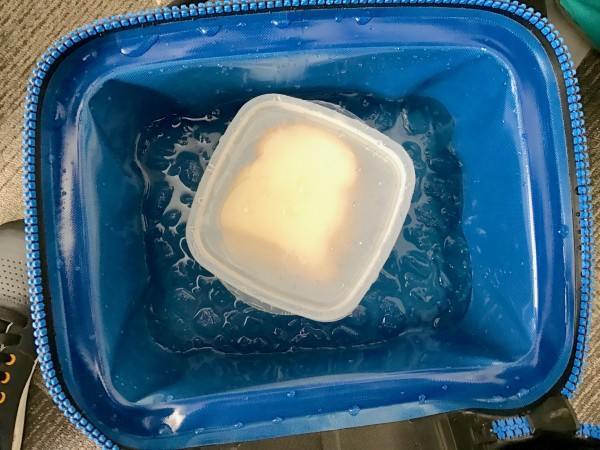
In order to test insulation, all the products in this category were subjected to a head-to-head ice retention test. Each model was packed with only a seven-pound bag of cubed ice and placed in the same un-insulated, unlit shed. For the new coolers, we tested we also added a temperature gauge so we could check in on the internal temperature. Every 24 hours we peeked in each one and weighed the remaining ice. All had some ice left at 24 hours. The Coleman, which is the smallest in our test, was out of ice by 48 hours. Only two made it to 72 hours with ice intact. We were particularly impressed with these two models when it came to insulation. Unsurprisingly, Yeti, the industry leader in high-end coolers, came through on top. The Hopper Flip 12 had 15 ounces of ice remaining at the 72-hour mark, making it the best in the test, and the larger Yeti Hopper Two 30 came in second with an impressive 14 ounces. Coming in at an amazingly surprising third place is the Polar Bear Coolers 24 Pack, which held onto nine ounces of ice for 72 hours, which is very close to the result of the significantly more expensive Yeti.
Each of these has drawbacks, but some change the insulation value more than others. During our tests we found the Yeti Hopper Two 30, with its combination of thick insulation and a sealed zipper, to be the most effective, followed by the underdog Polar Bear 24 Pack. These two had the winning insulation combo to get the job done.
Durability
This, aside from insulation, might be one of the most important factors in choosing a soft cooler, or any product really. It may be the coolest thing ever, but if it doesn’t last, what’s the point?
Durability is a serious question.
Overall durability comes down to a few simple qualities: the material it is made from, the construction style and manufacturing, and the components (zippers, buckles, straps, etc.). Our test models were made from various materials. The lower end models used light to mid-weight nylon or canvas with middle-of-the-road zippers and regular construction in terms of stitching or heat welding. The higher-end more expensive models were made from heavy rubber, had burly zippers and components, and much more robust construction. All of these aspects affect the overall durability and lasting power.
The Coleman 16-Can and the eBags Crew Cooler II performed the poorest when it came to durability. The lightweight nylon and the average construction of these models aren’t made for the long haul. However, neither of these models were designed with the backcountry hardcore user in mind.
The Yeti Hopper Two 30, the Yeti Hopper Flip 12, and the Ice Mule Pro performed the best in our use and durability tests. They have exteriors of heavy rubber and are built to last. They are examples of coolers made for a particular purpose, and they performed as such.
Our other two models, the Polar Bear 24 Pack, and the AO Coolers 24 Pack Canvas Cooler performed very similarly in this department, with the Polar Bear edging slightly above the AO for durability.
Ease of Use
Aside from insulation and durability, how easy it is to use the darned thing? This is an important question. The ability to open and close, stuff things in there, get things out, clean it, and carry it around are all important considerations. Again, the intended use comes into mind. Questions of: what do you want to do with a cooler, and where do you want to go with it? factor into ease of use distinctions.
Starting out with how easy it was to open and close various models, we looked at the differing closure methods. Zippers are pretty standard. The wide mouth zippers found on the Polar Bear 24 Pack and the AO 24 Pack were extremely easy to get into and pull items out of. They were also easy to open wide and took very little effort to hold open. The Yeti Hopper Two 30, with its recently redesigned closure system, was also very easy to get in and out of. It also has extra tie down points, daisy chain, and many handle options. The Yeti Hopper Flip 12 has a wider opening than its larger sibling and similar handles. Occasionally the zipper felt a bit sticky when going past one of the corners, so we gave it a slightly lower score. The Ice Mule Pro, with its wide mouth roll top, was the easiest all around to open and get in and out of. The Coleman 16-Can was also very easy, given its more traditional lid rather than a straight zipper. The ease of access issue also played into how easy the coolers were to clean. The easier it is to get into, the easier it is to clean, as a rule. The next thing we looked at was how easy each was to carry around. This all plays into portability.
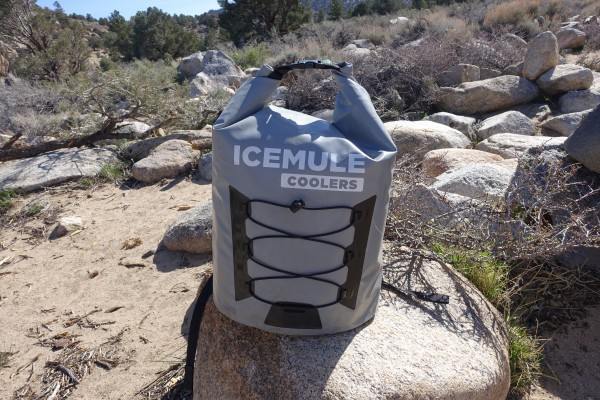
Portability
Getting back to the “Where do you want to go with it?” question, let’s discuss portability. Inevitably you will be carrying something around in your cooler, otherwise, why would you have it? These insulated bags are designed to be moved around. However, one must again consider the intended use. Are you looking for something that you can take from your car to the beach? Down the street to a friend’s? Or do you want something you can comfortably carry five miles into your secret fishing hole?
We looked for features in all our test models aimed at the ever important carry. Most of our test models have a shoulder strap and carry handles. This is great for shorter distances and most uses, like from car to picnic table, but on longer hauls, a shoulder strap can be a drag. That said, not all shoulder straps are created equal. More padded straps like that found on the Yeti Hopper models made slightly longer carries a little more bearable where less or non-padded straps like those found on the AO 24 Pack and the Coleman 16-Can were significantly less pleasant to carry for any significant distance.
Other models are made precisely for the longer distance carry. The Ice Mule Pro was made for carrying comfortably. Equipped with backpack straps and a padded, ventilated back panel, we found that we could take the Ice Mule out for multi-mile treks comfortably.

Accessories
Accessories are less of an important purchasing consideration or performance metric and are more of a cool or increased usefulness feature. Soft coolers by nature are pretty minimalist, leaving little room for add-ons. Additional straps or bottle opener attachments add some convenience but don’t affect the overall usability.
Conclusion
When you first think about a soft cooler, they all seem the same: a bag, some insulation, some sort of way to close and carry it, and we’re done. But the world of these products is the same as other gear we review. We have very different performance for different products. We were able to separate the various coolers by five different rating metrics and, hopefully, compile enough information to help inform your purchasing decisions.
Matt Baker

